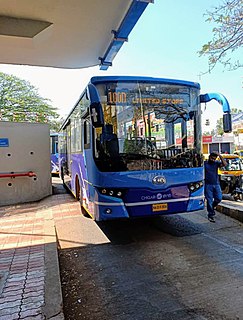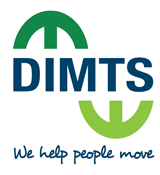
Bus rapid transit (BRT), also called a busway or transitway, is a bus-based public transport system designed to have much more capacity, reliability and other quality features than a conventional bus system. Typically, a BRT system includes roadways that are dedicated to buses, and gives priority to buses at intersections where buses may interact with other traffic; alongside design features to reduce delays caused by passengers boarding or leaving buses, or paying fares. BRT aims to combine the capacity and speed of a light rail line with the claimed flexibility, lower cost and simplicity of a bus system.

Bhubaneswar is the capital and largest city of the Indian state of Odisha. The region, especially the old town, was historically often depicted as Ekamra Khetra. Bhubaneswar is dubbed the "Temple City", a nickname earned because of the 700 temples which once stood there. In contemporary times, it has emerged as an education hub and an attractive business destination.
The Urban Ring was a proposed project of the Massachusetts Bay Transportation Authority and the Massachusetts Department of Transportation, to develop new public transportation routes that would provide improved circumferential connections among many existing transit lines that project radially from downtown Boston. The Urban Ring Corridor is located roughly one to two miles from downtown Boston, passing through the Massachusetts cities of Boston, Chelsea, Everett, Medford, Somerville, Cambridge, and Brookline. The project was expected to convert 41,500 car trips to transit trips daily.

The Mississauga Transitway is a bus rapid transit (BRT) system in Mississauga, Ontario, Canada. It comprises a series of purpose-constructed bus-only roadways, as well as reserved lanes on existing city streets and portions of Highway 403, that together form a continuous 18 km (11 mi) route spanning most of the city from Winston Churchill Boulevard in the west to the junction of Highways 401 and 427 in the east on the border with Toronto. Service on the Transitway is provided by MiWay and GO Transit, with some stations providing connections to Brampton Transit and Toronto Transit Commission bus services.

CEPT University, formerly the Centre for Environmental Planning and Technology, is an academic institution located near university area in Ahmedabad, India offering undergraduate, postgraduate and doctoral programmes in areas of natural and developed environment of human society and related disciplines.

Van Ness Bus Rapid Transit is a bus rapid transit (BRT) corridor on Van Ness Avenue in San Francisco, California, United States. The 1.96-mile (3.15 km) line, which runs between Mission Street and Lombard Street, has dedicated center bus lanes and nine stations. It was built as part of the $346 million Van Ness Improvement Project, which also included utility replacement and pedestrian safety features. Van Ness Bus Rapid Transit is used by several San Francisco Municipal Railway (Muni) lines including the 49 Van Ness–Mission, as well as three Golden Gate Transit routes.

Janmarg, also known as Ahmedabad BRTS, is a bus rapid transit system in Ahmedabad, Gujarat, India. It is operated by Ahmedabad Janmarg Limited, a subsidiary of Ahmedabad Municipal Corporation and others. It is designed by CEPT University. It was inaugurated in October 2009. The network expanded to 89 kilometres (55 mi) by December 2017 with daily ridership of 3,49,000 passengers. BRTS won several nation and international awards for design, implementation and operation. It was rated Silver on BRT Standard in 2013.

The Institute for Transportation and Development Policy (ITDP) is a non-governmental non-profit organization that focuses on developing bus rapid transit (BRT) systems, promoting biking, walking, and non-motorized transport, and improving private bus operators margins. Other programs include parking reform, traffic demand management, and global climate and transport policy. According to its mission statement, ITDP is committed to "promoting sustainable and equitable transportation worldwide."

Walter B. Hook is an urban planner and expert in the field of sustainable transportation policy and practice. Since 2015, Dr. Hook has been a Principal at BRT Planning International, LLC, a boutique BRT planning firm. From 1993 until 2014, Hook worked as the Chief Executive Officer for the Institute for Transportation and Development Policy (ITDP), a nonprofit agency that promotes environmentally sustainable and equitable transportation policies and projects in the developing world. Under the auspices of ITDP, Hook worked on the design and implementation of numerous bus rapid transit (BRT) systems in Asia, Africa, and Latin America, and is considered a leading expert on BRT design and policy. He collaborated extensively with Enrique Peñalosa, former mayor of Bogotá, Colombia, and creator of the TransMilenio, one of the world's premier BRT systems. Additionally, Hook has campaigned for sustainable transport and urban planning practices in the U.S.

The Cebu Bus Rapid Transit System is a planned mass transit system for Cebu City located within the greater Cebu Metropolitan Area. It is expected to become the first operational bus rapid transit project in the Philippines. Only one line has been planned in detail so far, but scheme developers note the potential to develop a larger network comprising the adjacent cities Lapu-Lapu, Mandaue and Talisay. Leadership in both Lapu-Lapu and Mandaue have shown interest in the network. This will be constructed at the end or last quarter of 2017 and the first route could be operational by the end of 2019.

Bus rapid transit in New Jersey comprises limited-stop bus service, exclusive bus lanes (XBL) and bus bypass shoulders (BBS). Under the banner Next Generation Bus New Jersey Transit (NJT), the New Jersey Department of Transportation (NJDOT), and the metropolitan planning organizations of New Jersey (MPO) which recommend and authorize transportation projects are undertaking the creation of several additional bus rapid transit systems (BRT) in the state.

Bhubaneswar has roads in grid form in the central city. Bhubaneswar has approximately 1,600 kilometres (990 mi) of roads, with average road density of 11.82 square kilometres (4.56 sq mi). Baramunda Inter State Bus Terminus (ISBT) is the major bus terminus in the city from where buses ply to all the districts in Odisha as well as to neighbouring state's cities like Hyderabad, Kolkata, Visakhapatnam, Raipur and Ranchi. City bus service runs in public-private partnership between Bhubaneswar-Puri Transport Service Limited (BPTSL) and Dream Team Sahara (DTS) under JNNURM scheme. A fleet of 185 buses cover all major destinations including Cuttack, Puri and Khordha. Auto rickshaws are available for hire and on a share basis throughout the city. In parts of the city, cycle rickshaws offer short trips. To ease traffic jams, over-bridges at major road junctions and expansion of roads are under construction. In a study of six cities in India, Bhubaneswar was ranked third concerning pedestrian infrastructure. The city scored 50 points out of maximum 100. The government of Odisha introduced the much-awaited Bhubaneswar BRTS in Bhubaneswar.

Hubballi-Dharwad BRTS - (HDBRTS) is a bus rapid transit system built to serve the twin cities of Hubballi and Dharwad, located in the North-Western part of Karnataka state in India. Hubballi-Dharwad BRTS (HDBRTS) project is a Government of Karnataka initiative to foster long-term economic growth in the region. The project promotes fast, safe, comfortable, convenient and affordable public transportation between the twin cities and aims to reduce congestion and air pollution in the region.

Dar es Salaam bus rapid transit is a bus rapid transit system that began operations on 10 May 2016 in Dar es Salaam, Tanzania. The transit system consists of 6 phases and the construction of the first phase began in April 2012 by the Austrian construction company Strabag International GmbH. Construction of the first phase was completed in December 2015 at a total cost of €134 million funded by the African Development Bank, World Bank and the Government of Tanzania. The first phase of the project has a total length of 21.1 kilometers with dedicated bus lanes on three trunk routes with a total of 29 stations. The entire system is operated by The Usafiri salama Dar es Salaam Rapid Transit (UDA-RT) under the surveillance of the Surface and Marine Transport regulatory authority (Sumatra) Currently, the route is serviced by a fleet of 140 Chinese built Golden Dragon buses, providing express and local service for 18 hours daily from 05:00am to 11:00pm. As of September 2022, BRT Fleet size has increased to 305.

Delhi Integrated Multi-Modal Transit System (DIMTS) Limited is transport consultancy and infrastructure development company. It is a joint venture company with equal equity of the Government of National Capital Territory of Delhi (GNCTD) and the IDFC Foundation.
The Cuttack Bhubaneswar Metro is a rapid transit system proposed for the cities Cuttack and Bhubaneswar, Odisha, India.

Bimal Hasmukh Patel is an architect from Gujarat, India, with over 35 years of professional, research and teaching experience in architecture, urban design and urban planning. He is President of CEPT University in Ahmedabad and leads HCP Design Planning and Management Private Limited, an architecture, planning and project management firm. He also founded Environmental Planning Collaborative, a not-for-profit, planning research and advocacy organization.

Rainbow BRTS is a bus rapid transit system in the city of Pune. The system is operated by the Pune Mahanagar Parivahan Mahamandal Limited (PMPML). The infrastructure has been developed by the Pune Municipal Corporation & Pimpri Chinchwad Municipal Corporation, Pune. The project currently envisages 113 km of dedicated bus corridors along with buses, bus stations, terminals and intelligent transit management system.
TransPeshawar or Peshawar BRT is a bus rapid transit system in Peshawar, capital of Pakistan's Khyber Pakhtunkhwa (KP) province. TransPeshawar BRT system consists of two parts: the first encompasses an east–west corridor served by 32 stations on a dedicated lane for exclusive use by buses, while the second part consists of a network of feeder routes in which buses can enter and exit the system to travel on city streets. The system was inaugurated on August 13, 2020, and is the fourth BRT system in Pakistan.
The Cebu Monorail Transit System, simply known as the Cebu Monorail, is a proposed monorail rapid transit system to be built in Metro Cebu, Philippines. Originally proposed by the Japanese in 2015 as the Cebu MRT System, it was revised to a light rail line in the late 2010s, dubbed the Cebu Light Rail Transit System or Cebu LRT. It was then again revised to its present form in late 2019.















